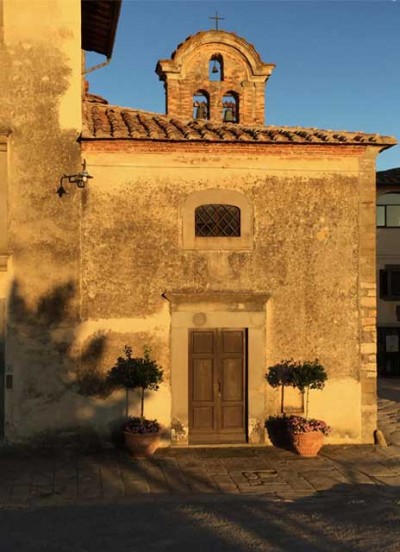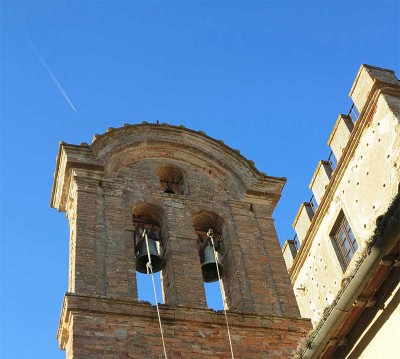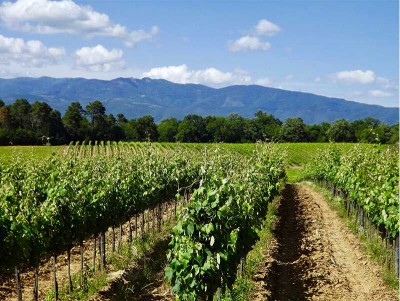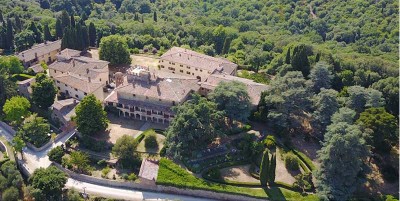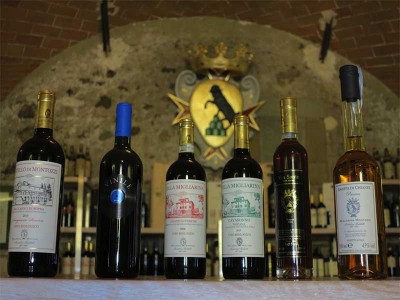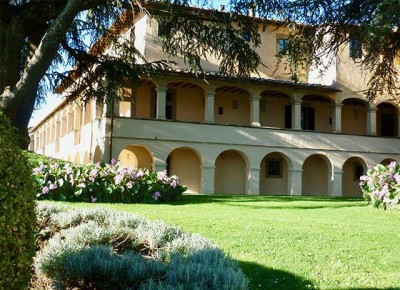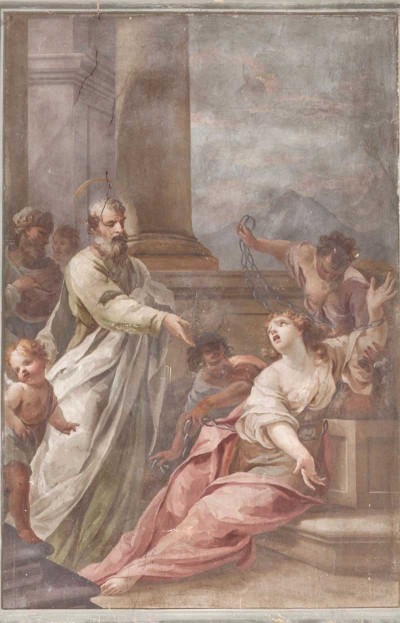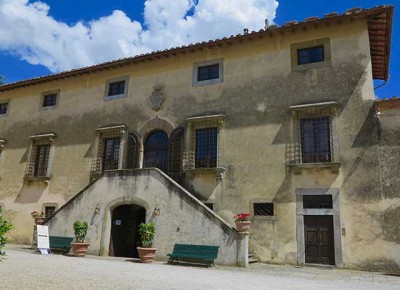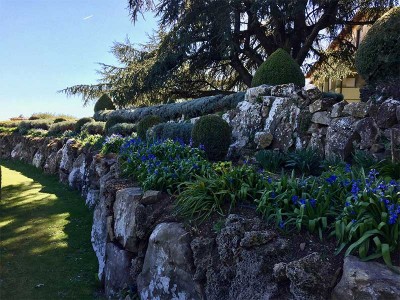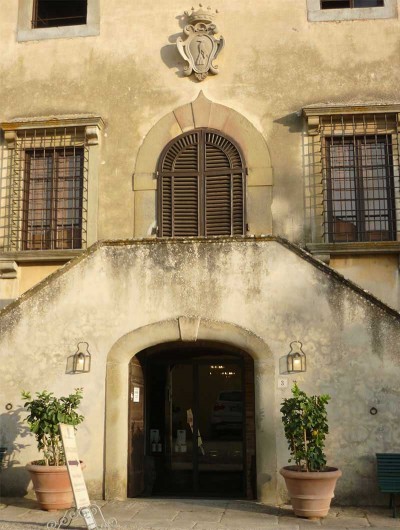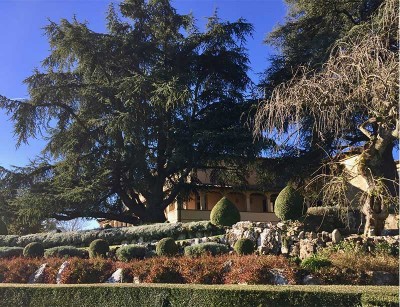Contact the abode
CASTELLO DI MONTOZZI: AGRITOURISM ACCOMMODATION IN PERGINE VALDARNO
Castello di Montozzi enjoys an incredible panoramic position overlooking the Val d'Arno di Sopra (the Upper Arno Valley), the Val d'Ambra valley, the Chianti hills and the Pratomagno mountain range. The medieval fortified structure, still visible today, has been transformed over the centuries into a charming hamlet.
The hill, from the summit of which communication routes and territories disputed between the Guelphs and the Ghibellines were once controlled, is now surrounded by a crown of olive trees. Inside the ancient walls, public buildings, vegetable gardens and orchards have appeared, which in springtime are the pride and joy of the locals and a real star attraction.
In 1600, the crumbling stones that had once constituted the stronghold of Teuzzo dei Sassi, Lord of the Bulgars, were reassembled to create the Villa-Palazzo of prelates Francesco and Ottavio Bartolini Baldelli, who wanted to live in a residence of noble proportions that nevertheless avoided any excessive extravagances, echoing the model of simple and sober harmony found in many Florentine palazzos and villas at the time. Their choices were also guided by a spirit of genteel moderation that was well suited to their general attire and profession as Secretaries for Cosimo III.
At the beginning of the 18th century, the rather more frivolous and worldly Francesco Maria Bartolini Baldelli and his wife Maria Maddalena Giraldi commissioned the addition of a double loggia overlooking the garden to soften the solid structure built by their forebears, in addition to a new church. This fascinating creation and structural feature added great charm and made the appearance of the original conception more dynamic and graceful. During that period, Francesco Maria served as Lieutenant at the Accademia delle Arti del Disegno (Academy of the Arts of Drawing), the administrative hub for artists in Florence, and it was here that he was inspired to give Villa di Montozzi a further touch of elegance, entrusting the fresco decoration to painter Giovanni Camillo Sagrestani and the stucco work to Giovanni Martino Portogalli.
The park, as we see it today, was essentially conceived and created in the mid-19th century by Marquis Bartolommeo Bartolini Baldelli. As Chief Steward of the Imperial and Royal Court of Lorraine, he was able to draw on the expertise of the staff at Palazzo Pitti, and he was assisted in his work at Montozzi by Angiolo Pucci, expert gardener at the Royal Botanical Garden of Boboli. Various influences and affinities with the urban creations of Giuseppe Poggi are also evident in terms of the details and reduced size in the new design.
THE HISTORY OF CASTELLO DI MONTOZZI
The first mention of a fortification known as ‘Mons Teuzi’ dates back to 1036 and was named after its owner, Teuzzo di Ildebrando dei Sassi, Lord of the Bulgars. This record certifies the presence of Montozzi for the first time.
During the Middle Ages, the Castello di Montozzi, situated at the crossroads of an intense road network connecting Florence, Siena and Arezzo, and with a strategically dominant position over the Upper Arno Valley and the Val d'Ambra valley, was intensely contested between the two major feudal lords of the region: namely, the Ubertini and Guidi families. The Castle was at the forefront of many fierce battles between the Guelphs and the Ghibellines was destroyed and rebuilt several times, following a series of turbulent and dramatic trials and tribulations. From 1400 onwards, the entire Val d'Arno di Sopra area came under the rule of Florence, and Montozzi lost its original military connotation, gradually transforming into a village at the centre of a populous and active agricultural territory. Among the families who decided to invest in the buildings and land of the ancient Castle in the early 1500s were the Bartolini Baldellis, who eventually became the sole owners with the passing of time.
The Bartolini Baldelli family belonged to the feudal nobility of Cortona. At the beginning of the 1400s, Bartolommeo di Piero Baldelli had moved to the fiefdom of Montelungo near Terranuova in the Val d'Arno di Sopra area, giving rise to the branch of the family that became known as Bartolini Baldelli. From the mid-1500s, they became Florentine citizens and were soon heavily engaged at the court, performing multiple roles for all the Medici and Lorraine Grand Dukes, resulting in great wealth and glory being bestowed upon this provincial family.
As was common for Florentine aristocrats, their commitments in the capital never deterred the Bartolini Baldelli family from taking meticulous and passionate care of their estates, and this has remained a constant throughout the centuries to the present day, with Montozzi always being at the very centre of their interests. The Castle today is a clear demonstration of its almost thousand-year history, during which it has undergone many necessary renovations. Self-sufficient until the 1950s, it provided its inhabitants not only with respectable livelihoods but also a home, a school, a church, shops and workshops. Silk and hemp were woven, bricks for new buildings were baked, and in the large sawmill, beams and ironwork were all crafted within the complex. The land provided everything the community of the large estate needed: raw materials, livestock, crops … and good wine ...!
For the past 500 years, the Bartolini Baldelli family has managed this industrious history with unwavering dedication and passion, successfully integrating Montozzi into the fast-paced flow of the contemporary global world.
THE VILLAGE AND THE CASTLE TODAY
Although restored, the hamlet still retains its original appearance today. Together with the park and church, the Villa has been placed under protection by the local authorities at the request of the owners, Giovanni Battista and Piero Bartolini Baldelli. The park is expertly maintained, with absolute respect for its structure and original plantings by Marzia Piccolomini Bartolini Baldelli. This task has become more challenging in recent years due to the vagaries of climate change and new threats to traditional flora.
THE AGRICULTURAL ESTATE
The large agricultural estate, entirely managed by Carlo and Antonio Bartolini Baldelli, encompasses over 600 hectares of land, including arable land, vineyards, olive groves and deciduous forests. Since 2010, an exclusively organic cultivation method has been adopted, resulting in exceptional products: fine wines (Chianti and IGT), excellent olive oil, ‘ancient’ wheat with a low gluten content and organic medicinal herbs.
THE HUNTING RESERVE
The family's large hunting reserve, which over the years has evolved into a ‘Wildlife Hunting Company’ and is managed by Carlo Bartolini Baldelli, is involved in the containment of ungulates and the repopulation of various animal species such as hares and pheasants.
FACILITIES AND SERVICES: AGRITOURISM ACCOMMODATION, AGRICULTURAL ESTATE AND WINE AT CASTELLO DI MONTOZZI
The estate is a prestigious wine-producing reality in the heart of Tuscany, an evocative place where nature and human hands work together in perfect harmony.
The combination of land exposed to a mild climate and vineyards on sunny slopes produces high-quality grapes, unique for their full-bodied flavour.
THE AGRICULTURAL ESTATE AND OLIVE OIL
Tradition is at the heart of the production of extra virgin olive oil. The olives derive the best benefits from being cultivated in a unique territory in terms of its climate and morphological properties, resulting in a superior category oil which has an intense aroma, low acidity and a vibrant green colour. These characteristics only serve to further enhance what is an essential ingredient of a correct Mediterranean diet, guaranteeing its lightness, healthy qualities and flavour.
ANCIENT ORGANIC GRAINS
Organic grains and spelt wheat represent some of the company's most outstanding products. In particular, ‘Ancient Grains’ are an exceptional rediscovery and form the basis of products with low gluten content. The land at Montozzi also produces organic pulses and medicinal herbs, which provide a healthy meal for the livestock on many farms in Tuscany.
AGRITOURISM ACCOMMODATION IN THE VAL D’ARNO AREA
Our charming agritourism at Castello di Montozzi is the ideal place to immerse yourself in Tuscan authenticity and savor its genuine products.

